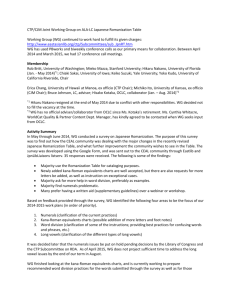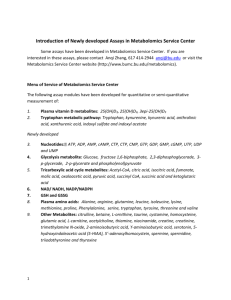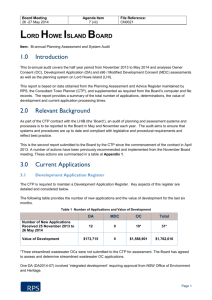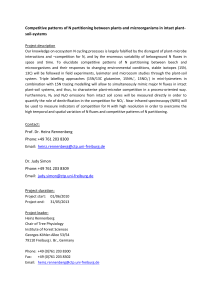Onco-neural antibodies and tumor type determine survival and
advertisement
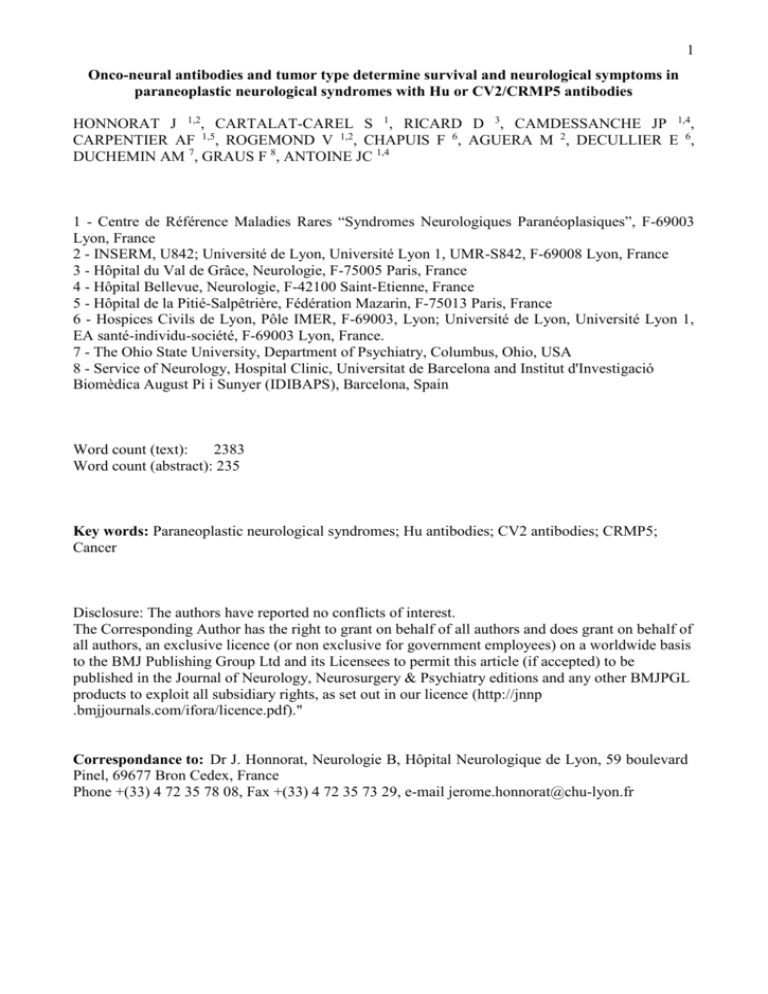
1 Onco-neural antibodies and tumor type determine survival and neurological symptoms in paraneoplastic neurological syndromes with Hu or CV2/CRMP5 antibodies HONNORAT J 1,2, CARTALAT-CAREL S 1, RICARD D 3, CAMDESSANCHE JP 1,4, CARPENTIER AF 1,5, ROGEMOND V 1,2, CHAPUIS F 6, AGUERA M 2, DECULLIER E 6, DUCHEMIN AM 7, GRAUS F 8, ANTOINE JC 1,4 1 - Centre de Référence Maladies Rares “Syndromes Neurologiques Paranéoplasiques”, F-69003 Lyon, France 2 - INSERM, U842; Université de Lyon, Université Lyon 1, UMR-S842, F-69008 Lyon, France 3 - Hôpital du Val de Grâce, Neurologie, F-75005 Paris, France 4 - Hôpital Bellevue, Neurologie, F-42100 Saint-Etienne, France 5 - Hôpital de la Pitié-Salpêtrière, Fédération Mazarin, F-75013 Paris, France 6 - Hospices Civils de Lyon, Pôle IMER, F-69003, Lyon; Université de Lyon, Université Lyon 1, EA santé-individu-société, F-69003 Lyon, France. 7 - The Ohio State University, Department of Psychiatry, Columbus, Ohio, USA 8 - Service of Neurology, Hospital Clinic, Universitat de Barcelona and Institut d'Investigació Biomèdica August Pi i Sunyer (IDIBAPS), Barcelona, Spain Word count (text): 2383 Word count (abstract): 235 Key words: Paraneoplastic neurological syndromes; Hu antibodies; CV2 antibodies; CRMP5; Cancer Disclosure: The authors have reported no conflicts of interest. The Corresponding Author has the right to grant on behalf of all authors and does grant on behalf of all authors, an exclusive licence (or non exclusive for government employees) on a worldwide basis to the BMJ Publishing Group Ltd and its Licensees to permit this article (if accepted) to be published in the Journal of Neurology, Neurosurgery & Psychiatry editions and any other BMJPGL products to exploit all subsidiary rights, as set out in our licence (http://jnnp .bmjjournals.com/ifora/licence.pdf)." Correspondance to: Dr J. Honnorat, Neurologie B, Hôpital Neurologique de Lyon, 59 boulevard Pinel, 69677 Bron Cedex, France Phone +(33) 4 72 35 78 08, Fax +(33) 4 72 35 73 29, e-mail jerome.honnorat@chu-lyon.fr 2 Abstract Objective: Anti-Hu antibodies (Hu-Ab) and anti-CV2/CRMP5 antibodies (CV2/CRMP5Ab) have been identified in association with paraneoplastic neurological disorders. However, it is not clear whether these antibodies are associated with specific neurological symptoms or are only markers of anti-cancer immune reaction. Methods: To address this question, we compared 37 patients with CV2/CRMP5-Ab and 324 patients with Hu-Ab. Results: Whereas the age and sex ratio were the same between the two groups, the distribution of neurological symptoms was not. Patients with CV2/CRMP5-Ab presented more frequently cerebellar ataxia, chorea, uveo/retinal symptoms and myasthenic syndrome (LambertEaton myasthenic syndrome LEMS or myasthenia gravis). They also had better Rankin score. On the opposite, dysautonomia, brainstem encephalitis and peripheral neuropathy were more frequent in patients with Hu-Ab. Limbic encephalitis occurred similarly in both groups. Small cell lung cancer (SCLC) was the most frequently associated tumor in both groups of patients while malignant thymoma was observed only in patients with CV2/CRMP5-Ab. In particular, patients with CV2/CRMP5-Ab and thymoma developed more frequently myasthenic syndrome while patients with SCLC developed more frequently neuropathies. Chorea and myasthenic syndrome were only seen in patients with CV2/CRMP5-Ab. The median survival time was significantly longer in patients with CV2/CRMP5-Ab and this effect was not dependent on the type of tumor. Interpretation: Our data demonstrate that in patients with paraneoplastic neurological syndromes, the neurological symptoms and survival vary with both the type of associated onconeural antibody and the type of tumor. 3 INTRODUCTION During the past years, several onconeural antibodies have been identified in association with a variety of paraneoplastic neurological disorders (PND). Many of them led to described PND.[1] Some of them like anti-Yo or anti-Tr antibodies are clearly associated with one neurological disorder (in this case, cerebellar ataxia). However, in many cases, whether these antibodies are associated with specific set of neurological symptoms1 or are only markers of the type of cancer2 remains unclear. Thus, there is a need to determine if a specific neurological syndrome occurs with a given antibody. Anti-CV2/CRMP5 antibodies (CV2/CRMP5-Ab) were first described in a patient with cerebellar ataxia, peripheral neuropathy, uveitis and axillary lymph node metastasis of an undifferentiated carcinoma.3 Since this first description, the specific association of CV2/CRMP5Ab with PND has been confirmed in many other cases.4-9 CV2/CRMP5-Ab have been reported with PND involving different structures of the central and peripheral nervous system and small cell lung cancer (SCLC) is the most frequently associated tumor. These features seem to be very similar to the Hu-Ab-associated PND.10 Furthermore, both antibodies may occur simultaneously in a same patient4 and SCLC is the most frequently associated tumor in both groups. However, it is not really known if the neurological symptoms differ or not between these 2 groups of patients. To address the specificity of the clinical presentation associated with CV2/CRMP5-Ab or Hu-Ab, we compared the clinical and tumoral features of patients presenting at least one of these antibodies. METHODS Patients Data from patients with onset of the PND between January 1993 and December 2001 were retrospectively reviewed in the database of two centers: Rare Disease Reference Center for PND (Lyon-St-Etienne-Paris, France) and Barcelona (Spain). Clinical information on the neurological symptoms, severity of the neurological status, delay in the neurological diagnosis, tumor diagnosis and staging, and outcome of the patients were obtained from forms filled out by the referring neurologists, telephone interviews and review of the clinical records. The clinical symptoms of the patients were coded into eight syndromes according to the published PND criteria:1 neuropathy (clinical symptoms or electrophysiological evidences), cerebellar degeneration, limbic encephalitis, optic neuritis or retinitis (visual acuity alteration with papillitis oedema), myasthenic syndrome (myasthenia gravis or Lambert-Eaton myasthenic syndrome), chorea, dysautonomia and brainstem encephalitis. The neurological disability was evaluated by a modified Rankin scale.11 Onconeural antibodies analysis The patient sera were tested for the presence of onconeural antibodies by immunohistochemistry using paraformaldehyde fixed sections of adult rat brain and western-blotting.4 All sera were tested for Hu, Ri, Yo, CV2/CRMP5, Tr and amphiphysin antibodies. The presence of CV2/CRMP5-Ab was affirmed when (1) the serum immunolabelled the cytoplasm of oligodendrocytes in the cerebellum and brainstem and (2) immunoreacted with the recombinant CRMP5 protein by western-blotting.6, 8 The presence of Hu-Ab was confirmed by Western blotting using recombinant HuD protein (provided by Dr J. Dalmau, Philadelphia, USA). 4 Statistical analysis Descriptive results were expressed as percentages for qualitative data and means (and relative standard deviations) for quantitative data. Comparisons between groups were realized by the Chi-square test for qualitative data (or by the Fisher exact test when the hypothesis for the Chi-square test were not fulfilled) and by the MannWhitney non parametric test for quantitative data. Time between onset of neurological symptoms to death or to last visit was computed and a KaplanMeyer survival analysis was performed. Survival curves were compared using a Log-rank test. Antibody status was also entered into a proportional hazard model (Cox regression) with adjustment for age, sex, Rankin score and single versus multiple neurological signs (neuropathy, limbic encephalitis, dysautonomy, brainstem encephalitis and cerebellar ataxia). RESULTS We selected 47 patients with CV2/CRMP5-Ab for whom all clinical records were available in the database. Thirty-seven had only CV2/CRMP5-Ab and 10 had both Hu-Ab and CV2/CRMP5Ab. To perform clinical comparisons, we selected 324 patients with Hu-Ab and complete clinical information in the databases. Clinical syndromes of CV2/CRMP5-Ab versus Hu-Ab patients While some of the characteristics of the two groups of PND patients were similar, neurological disorders associated with CV2/CRMP5-Ab did not parallel those associated with HuAb (Table 1). Patients with CV2/CRMP5-Ab had significantly more frequent cerebellar ataxia (p=0.001), chorea (p=0.01), uveo/retinal symptoms (p=0.003) and neuromuscular junction abnormalities (myasthenia gravis or Lambert-Eaton myasthenic syndrome LEMS, p=0.004) and less peripheral neuropathy (p<0.001), brainstem encephalitis (p=0.02) and dysautonomia (p=0.009) than patients with Hu-Ab. In addition, the Rankin score at diagnosis was higher in patients with HuAb than in patients with CV2/CRMP5-Ab. In contrast, the frequency of limbic encephalitis was the same between the two groups. There was also no difference between the two patient groups concerning age, sex ratio or the cause of death. 5 Table 1: Comparison of clinical characteristics of patients with CV2/CRMP5-Ab (CV2) and Hu-Ab (Hu)a. CV2 Hu Hu vs CV2 CV2 + Hu Hu vs n=37 n=324 (p-value*) n=10 CV2 + Hu (p-value*) Age range (mean±SD) 62±11 62±11 NS 65±7 NS Male 28 (76) 249 (77) NS 6 (60) NS Female 9 (24) 75 (23) 21 (56.8) 279 (86.1) <0.001 7 (70.0) NS Dysautonomy 2 (5.4) 79 (24.4) 0.009 0 (0.0) NS Myasthenic syndrome (LEMS + MG)** 5 (13.5) 0 (0.0) 0.004 0 (0.0) Limbic encephalitis 5 (13.5) 69 (21.3) NS 2 (20.0) NS Cerebellar ataxia 17 (45.9) 70 (21.6) 0.001 7 (70.0) 0.002 Brainstem encephalitis 1 (2.7) 58 (17.9) 0.02 0 (0.0) Chorea** 4 (10.8) 0 (0.0) 0.01 0 (0.0) Uveo/retinal symptoms** 8 (21.6) 2 (2.9) 0.003 0 (0.0) Sex 4 (40) Neurological signs (n): Neuropathy NS NS Rankin score (mean±SD) 2.5±1.5 3.1±1.3 Cancer (n) 34 278 SCLC 21 (61.8) 196 (70.5) Thymoma 5 (14.7) 0 (0.0) 1(11.1) Radiological evidence of lung cancer 2 (5.9) 26 (9.3) 0 Other 6 (17.6) 56 (20.1) 1 (11.1) ND<cancer 24 (72.7) 213 (77.5) ND=cancer 2 (6.1) 18 (6.5) 0 (0.0) Cancer<ND 7 (21.2) 44 (16.0) 1 (11.1) ND<cancer (mean±SD) 11.6±11.1 7.2±9.8 0.03 13.9±24.0 NS Cancer<ND (mean±SD) 24.1±37.3 15.0±31.5 NS 11.0±11.0 NS NS 1(12.5) ND and cancer 0.01 3.1±1.1 NS 9 <0.0001 NS 7 (77.8) 8 (88.9) 0.04 NS Mean time (month) Deceased (n) Cause of death a. 16 243 PNS 3 (18.8) 106 (43.6) 8 Cancer 8 (50.0) 90 (37.0) 5 (62.5) Other 5 (31.3) 47 (19.3) 2 (25.0) NS Results are expressed as n (%) unless otherwise stated. *: Khi or Fisher exact test for qualitative data and Mann-Whitney test for quantitative data. **: available in the data bases for only 69 patients with Hu-Ab and for all the patients with CV2/CRMP5-Ab. LEMS:Lambert-Eaton myasthenic syndrome; MG: myasthenia gravis; SCLC: small cell lung carcinoma; ND: neurological disease; NS: not significant. ND<cancer: ND diagnosed first. ND=cancer: ND and cancer diagnosed at the same time. Cancer<ND: cancer diagnosed first 6 Characteristics of peripheral neuropathy in CV2/CRMP5 patients versus Hu patients In order to compare the characteristics of the peripheral neuropathy, an analysis was performed on a subgroup of 17 patients with CV2/CRMP5-Ab and 16 patients with Hu-Ab. These patients were selected because of the availability of a detailed clinical and electrophysiological analysis and because they were examined by one of the coauthors. In this subgroup, mean age (62.6±10.6 versus 61.6±10.8 years), sex ratio (2.4 versus 4.3), Rankin score (3.23±1.2 versus 2.87±1.2) and time before cancer diagnosis (9.93±9.2 versus 9.31±11.9 months) were not significantly different between patients with CV2/CRMP5-Ab and patients with Hu-Ab, respectively. However, in patients with CV2/CRMP5-Ab, the peripheral neuropathy was more frequently sensory motor (76 % versus 31 % p=0.03) and less painful (41 % versus 82 %, p=0.02), the motor or sensory upper limb involvement was less frequent (53% versus 87%, p=0.03) while motor involvement was more frequent in the lower limbs (57 % versus 19 %). The peripheral neuropathy was the only neurological sign in 69 % of patients with Hu-Ab versus 35 % for patients with CV2/CRMP5-Ab (p=0.05). In patients with CV2/CRMP5-Ab, the neuropathy was more frequently associated with a central nervous system disorder, in particular cerebellar ataxia (p<0.02). Electrophysiologically, sensory action potentials were more frequently abnormal in patients with Hu-Ab (all sensory nerves: 3.3±4.3 versus 6.8±9 µV for CV2/CRMP5-Ab patients, p=0.02), and this was particularly evident in the upper limbs (2.9±4.1 versus 10.1±11.2 µV, p=0.002, respectively). On the opposite, motor conduction velocities were more altered in CV2/CRMP5-Ab patient’s lower limbs (35.5±13.9 versus 39.7±5.6 m/s for Hu-Ab patients, p=0.03). However motor conduction velocities in the upper limbs (49.2±10.5 for CV2/CRMP5-Ab patients versus 44.7±16 m/s for Hu-Ab patients) as well as the action potentials were normal in both groups. Type of tumor in CV2/CRMP5-Ab versus Hu-Ab patients Histological confirmation of cancer diagnosis was obtained in 32 patients with CV2/CRMP5-Ab (86.5 %), in 252 patients with Hu-Ab (77.8 %) and in 9 patients with both CV2/CRMP5-Ab and Hu-Ab (90 %) (Table 1). Furthermore, 2 CV2/CRMP5-Ab and 26 Hu-Ab patients showed radiological evidence of lung cancer. The three patients with CV2/CRMP5-Ab without evidence of cancer were heavy smokers who were lost at follow-up less than 6 months after the onset of the neurological syndromes. PND led to the diagnosis of the tumor in 72.7 % of patients with CV2/CRMP5-Ab and in 77.5 % of patients with Hu-Ab (not statistically different). The average time between the onset of the neurological disorders and the detection of the tumor was higher in patients with CV2/CRMP5-Ab than in patients with Hu-Ab antibodies (p=0.03) (Table 1). SCLC was the most frequently associated tumor in both groups and thymoma was found only in patients with CV2/CRMP5-Ab (Table 1). The other types of tumor observed in patients with CV2/CRMP5Ab were undifferentiated carcinoma in 2 cases (6.3%), prostate small cell carcinoma in 1 case (3.1%) and uterus sarcoma in 2 cases (6.3%). In patients with Hu-Ab, the main other associated cancers were lung adenocarcinoma in 19 cases (6.8%), prostate small cell carcinoma in 7 cases (2.5%) and gynecological cancer (breast, ovary, uterus) in 7 cases (2.5 %). Clinical characteristics of patients according to the type of cancer Neurological syndromes of CV2/CRMP5-Ab patients with malignant thymoma or SCLC were compared (Table 2). Patients with malignant thymoma were significantly younger (p=0.05) than patients with SCLC and characterized by the more frequent association with myasthenia gravis (p<0.01) and a less frequent association with neuropathy (p<0.01). 7 We also studied whether SCLC was associated with a particular clinical presentation depending on the type of antibody by comparing 21 patients with CV2/CRMP5-Ab, 196 with Hu-Ab and 7 with both antibodies. Differences were observed only for neuropathy (87.8% for Hu-Ab versus 66.7% for CV2/CRMP5-Ab, p=0.01), dysautonomy (24 % for Hu-Ab versus 4.8% for CV2/CRMP5-Ab, p=0.05) and uveo/retinal symptoms (19 % for CV2/CRMP5-Ab versus 0.5 % for Hu-Ab, p=0.03). The Rankin score was higher in patients with Hu-Ab than in patients with CV2/CRMP5-Ab (3.0±1.3 versus 2.2±1.6 p=0.02). Table 2: Comparison of neurological symptoms in patients with CV2/CRMP5-Ab only and thymoma or SCLCa. Thymoma SCLC n=5 n=21 49±12 60±9 0.05 Sex (M/F) 4/1 18/3 NS Neuropathy 0(0.0) 14 (66.6) 0.01 Dysautonomy 0 (0.0) 1 (4,8) NS Myasthenic syndrome (LEMS + MG) 3 (60.0) 2 (9.5) 0.03 Limbic encephalitis 2 (40.0) 2 (9.5) NS Cerebellar ataxia 1 (20.0) 8 (38.1) NS Chorea 1 (20.0) 2 (9.5) NS Uveo/retinal symptoms 0 (0.0) 4 (19.0) NS Gastroparesy 0 (0.0) 0 (0.0) NS Opsoclonus 0 (0.0) 5 (23.8) NS Mean age (years) (mean±SD) a p-value* : Results are expressed as n (%) unless otherwise stated. *: Khi or Fisher exact test for qualitative data and Mann-Whitney test for quantitative data. SCLC: Small Cell Lung Cancer; LEMS:Lambert-Eaton myasthenic syndrome; MG: myasthenia gravis; NS: not significant. Survival analysis The median survival time was significantly longer in patients with CV2/CRMP5-Ab than in patients with Hu-Ab or in patients with both antibodies (47.67 versus 11.46 and 18.00 months respectively, p=0.01) (Fig 1). This difference was still observed when only the subgroup of patients with SCLC was considered (52.50 versus 11.53 and 18.00 months respectively, p=0.01) (Fig 2). When adjusting for age, sex, Rankin score and type of neurological symptoms in the SCLC patients group (Cox regression), the difference of survival time between patients with CV2/CRMP5-Ab, HuAb and both antibodies was still significant (p=0.04). Patients with both antibodies displayed a median survival time similar to that of Hu-Ab patients but seem to have a clinical presentation similar to that of the CV2/CRMP5-Ab patients with more frequent cerebellar ataxia and association with malignant thymoma (Table 1). 8 DISCUSSION The present analysis shows that CV2/CRMP5-Ab and Hu-Ab define two different profiles of paraneoplastic encephalomyelitis despite their apparent similar clinical and oncological features and their possible simultaneous occurrence in the same patient. Comparatively to the Hu-Ab syndrome, the CV2/CRMP5-Ab syndrome is characterized by a high frequency of cerebellar ataxia, chorea and ocular manifestations including optic neuritis and posterior uveitis. Limbic encephalitis and diffuse encephalitis occur with the same frequency in both disorders. The neuropathy associated with CV2/CRMP5-Ab is also different from that of the Hu-Ab syndrome. The clinical and electrophysiological pattern of the Hu-Ab syndrome mainly corresponds to subacute sensory neuropathy as previously described10, 12-14 and is frequently an isolated or a markedly predominant manifestation of the Hu-Ab syndrome. Conversely, the CV2/CRMP5-Ab neuropathy is frequently integrated in a more complex sensorimotor neurological disorder. Nerve lesions in patients with CV2/CRMP5-Ab probably account for the electrophysiological pattern of the neuropathy which is marked by a more severe axonal and mildly demyelinating pattern,15 although motor nerve conduction velocities are also frequently mildly abnormal in patients with Hu-Ab.16 Our results contrast with those of the Mayo Clinic group who reported a more unspecific neurological disorder in patient with CRMP5-Ab9 and only recognized chorea, optic neuropathy and retinopathy as clinical manifestation typical of CRMP5-Ab.9, 17-20 The same group also suggested that, except anti-Yo/PCA1-Ab, all the other onconeural antibodies are frequently associated in a same patient and can only predict the presence of a tumor but not a specific neurological syndrome.2 The discrepancy between these results and ours may be explained by the fact that we used the “classical” criteria for the definition of the neurological syndromes.1 These criteria were published in 2004 after Yu et al publication.9 In addition, these authors used only Western blot analysis with recombinant protein and not immunohistochemistry for the diagnosis of CV2/CRMP5-Ab. However, we observed a few patients with low titers of antibodies recognizing CRMP5 epitopes only by Western blot and which were not associated with PND.21 Anti-CRMP5 antibodies predict PND only if a staining of oligodendrocytes is observed by immunohistochemistry.21 All these data demonstrate that the clinical analysis and the quality of data collection, like the biological criteria used to define onconeural antibodies, are essential to study the relationship between onconeural antibodies and PNDs. Another noteworthy result of our study, confirming previous reports,4, 9 is that CV2/CRMP5-Ab is associated mainly with SCLC and thymoma. The association of CV2/CRMP5Ab with thymoma is characteristic of this antibody. In our study, the long-term follow up of patients with thymoma excluded the possibility that an underlying SCLC had remained undiagnosed. Patients with thymoma and CV2/CRMP5-Ab were younger and developed more frequently myasthenia gravis and less frequently neuropathy than patients with SCLC. The clinical differences between thymoma and SCLC patients could reflect different mechanisms of immune reaction. Indeed, patients with thymoma frequently have immune responses against acetylcholine receptors or voltage-gated potassium channel while patients with SCLC may have low titers of Hu-Ab or other antibodies undetectable by our method. Furthemore, immunization against CRMP5 in this two types of tumor is probably different since SCLC express CRMP5 protein while thymoma do not.[22] An unexpected finding of this study is that the median survival time was significantly longer in patients with SCLC and CV2/CRMP5-Ab comparatively to patients with SCLC and Hu-Ab. This result was confirmed by the study of the 865 patients with PNS from the PNS EURONETWORK Database (http://www.pnseuronet.org). With the 344 Hu patients and 39 CV2/CRMP5 patients collected between 2000 and 2007 in this database, we observed exactly the same overall survival difference as in our study (data not shown, PNS EURONETWORK communication). The reason of this better prognosis is unclear. One can argue that Hu-patients have a more severe neurological syndrome than CV2/CRMP5 patients. However, our study showed that even if the Rankin score is 9 significantly higher in patients with Hu-Ab than in patients with CV2/CRMP5-Ab, the death by neurological disorders in patients with Hu-Ab is not significantly higher than in patients with CV2/CRMP5-Ab, suggesting that a more severe syndrome is not a clear explanation for the higher mortality. This is also suggested by the result of Cox regression including Rankin score. In any case, all these patients had a small cell lung carcinoma and the overall survival (52 months) of patients with CV2/CRMP5-Ab and this type of tumor is highly surprising. Further work will be necessary to understand this unexpected evolution. In conclusion, our study demonstrates that CV2/CRMP5-Ab syndrome appears to be an entity different from the Hu-Ab syndrome although both antibodies may simultaneously occur in a same patient. This study also suggests that the prognosis of the same type of tumor may be different according to the type of onconeural antibodies. ACKNOWLEDGMENT We thank Tam T. Quach for critical reading of the manuscript and Carlotta Rossi for studying the overall survival of patients with CV2/CRMP5- and Hu-Ab of the PNS EURONETWORK database and all the members of this network. 10 Figure 1: Survival curve for all patients with CV2/CRMP5-Ab (CV2), Hu-Ab (Hu) or both antibodies (Hu+CV2) 11 Figure 2: Survival curve for patients with SCLC and CV2/CRMP5-Ab (CV2), Hu-Ab (Hu) or both antibodies (Hu+CV2) 12 REFERENCES 1 Graus F, Delattre JY, Antoine JC, et al. Recommended diagnostic criteria for paraneoplastic neurological syndromes. J Neurol Neurosurg Psychiatry. 2004;75:1135-1140. 2 Pittock SJ, Kryzer TJ, Lennon VA. Paraneoplastic antibodies coexist and predict cancer, not neurological syndrome. Ann Neurol. 2004;56:715-719. 3 Antoine JC, Honnorat J, Vocanson C, et al. Posterior uveitis, paraneoplastic encephalomyelitis and auto-antibodies reacting with developmental protein of brain and retina. J Neurol Sci. 1993;117:215-223 4 Honnorat J, Antoine JC, Derrington E, et al. Antibodies to a subpopulation of glial cells and a 66 kDa developmental protein in patients with paraneoplastic neurological syndromes. J Neurol Neurosurg Psychiatry 1996;61:270-278. 5 Honnorat J, Aguera M, Zalc B, et al. POP66, a paraneoplastic encephalomyelitis-related antigen, is a marker of adult oligodendrocytes. J Neuropathol Exp Neurol. 1998;57:311-322. 6 Honnorat J, Antoine JC, Belin MF. Are the "newly discovered" paraneoplastic anticollapsin response-mediator protein 5 antibodies simply anti-CV2 antibodies? Ann Neurol. 2001;50:688-691 7 Rogemond V, Honnorat J. Anti-CV2 autoantibodies and paraneoplastic neurological syndromes. Clin Rev Allergy Immunol. 2000;19:51-59. 8 Ricard D, Rogemond V, Charrier E, et al. Isolation and expression pattern of human Unc-33-like phosphoprotein 6/collapsin response mediator protein 5 (Ulip6/CRMP5): coexistence with Ulip2/CRMP2 in Sema3a-sensitive oligodendrocytes. J Neurosci. 2001;21:7203-7214. 9 Yu Z, Kryzer TJ, Griesmann GE, et al. CRMP-5 neuronal autoantibody: marker of lung cancer and thymoma-related autoimmunity. Ann Neurol. 2001;49:146-154. 10 Graus F, Keime-Guibert F, Rene R, et al. Anti-Hu-associated paraneoplastic encephalomyelitis: analysis of 200 patients. Brain. 2001;124:1138-1148. 11 Graus F, Vega F, Delattre J, et al. Effect of plasmapheresis and antineoplastic treatment in CNS paraneoplastic syndromes with antineuronal antibodies. Neurology. 1992;42:536-540. 12 Denny-Brown, D. Primary sensory neuropathy with muscular changes associated with carcinoma. J. Neurol. Neurosurg. Psychiatry 1948;11:73–87. 13 Dalmau J, Furneaux HM, Rosenblum MK, et al. Detection of the anti-Hu antibody in specific regions of the nervous system and tumor from patients with paraneoplastic encephalomyelitis/sensory neuronopathy. Neurology. 1991;41:1757-1764. 14 Lucchinetti CF, Kimmel DW, Lennon VA. Paraneoplastic and oncologic profiles of patients seropositive for type 1 antineuronal nuclear autoantibodies. Neurology. 1998;50:652-657. 13 15 Antoine JC, Honnorat J, Camdessanche JP, et al. Paraneoplastic anti-CV2 antibodies react with peripheral nerve and are associated with a mixed axonal and demyelinating peripheral neuropathy. Ann Neurol. 2001;49:214-221. 16 Camdessanche JP, Antoine JC, Honnorat J, et al. Paraneoplastic peripheral neuropathy associated with anti-Hu antibodies. A clinical and electrophysiological study of 20 patients. Brain. 2002;125:166-175. 17 Thambisetty MR, Scherzer CR, Yu Z,et al. Paraneoplastic optic neuropathy and cerebellar ataxia with small cell carcinoma of the lung. J Neuroophthalmol. 2001;21:164-1677. 18 Vernino S, Tuite P, Adler CH, et al. Paraneoplastic chorea associated with CRMP-5 neuronal antibody and lung carcinoma. Ann Neurol. 2002;51:625-630. 19 Cross SA, Salomao DR, Parisi JE, et al. Paraneoplastic autoimmune optic neuritis with retinitis defined by CRMP-5-IgG. Ann Neurol. 2003;54:38-50. 20 Samii A, Dahlen DD, Spence AM, et al. Paraneoplastic movement disorder in a patient with non-Hodgkin's lymphoma and CRMP-5 autoantibody. Mov Disord. 2003;18:1556-1558. 21 Rogemond V, Cavillon G, Aguera M, et al. Immunohistochemistry is necessary to characterize anti-CV2/CRMP5 antibodies associated with paraneoplastic neurological syndromes. J Neuroimmunol. 2006;174 Suppl:200-201. 22 Camdessanché J-P, Lassablière F, Meyronnet D, et al. Expression of the onconeuronal CV2/CRMP5 antigen in thymus and thymoma. J Neuroimmunol. 2006;174:168-173.

